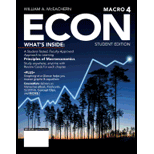
Sub-part
A
The initial effects on bank assets, liabilities, and reserves and assuming a
Concept Introduction:
The Federal Reserve and banking system are responsible for the creation of money in the economy. The first step of this money creation process starts when the Federal Reserve injects money in the economy by buying bonds. This money is stored in a bank. Then, the bank would keep the
Sub-part
B
The initial effects on bank assets, liabilities, and reserves and assuming a required reserve ratio of 0.05 when Fed loans $5 million to a bank.
Concept Introduction:
The Federal Reserve and banking system are responsible for the creation of money in the economy. The first step of this money creation process starts when the Federal Reserve injects money in the economy by buying bonds. This money is stored in a bank. Then, the bank would keep the required reserves with themselves, and lent the remaining excess reserves. These excess reserves will then be stored with some other bank and the other bank would also keep the required reserve and make a loan for the remaining amount. These excess reserves keep flowing in the economy, thus, creating money at every stage. A bank’s balance sheet has the deposit account and capital account on the liabilities side, and cash reserves, required reserves, loans, and securities are on the asset side of the bank’s balance sheet that are affected by the money creation process.
Sub-part
C
The initial effects on bank assets, liabilities, and reserves and assuming a required reserve ratio of 0.05 when Fed raises the required reserve ratio to 0.10.
Concept Introduction:
The Federal Reserve and banking system are responsible for the creation of money in the economy. The first step of this money creation process starts when the Federal Reserve injects money in the economy by buying bonds. This money is stored in a bank. Then, the bank would keep the required reserves with themselves, and lent the remaining excess reserves. These excess reserves will then be stored with some other bank and the other bank would also keep the required reserve and make a loan for the remaining amount. These excess reserves keep flowing in the economy, thus, creating money at every stage. A bank’s balance sheet has the deposit account and capital account on the liabilities side, and cash reserves, required reserves, loans, and securities are on the asset side of the bank’s balance sheet that are affected by the money creation process.
Trending nowThis is a popular solution!

Chapter 14 Solutions
ECON: MACRO4 (with CourseMate, 1 term (6 months) Printed Access Card) (New, Engaging Titles from 4LTR Press)
- You are the manager of a large automobile dealership who wants to learn more about the effective- ness of various discounts offered to customers over the past 14 months. Following are the average negotiated prices for each month and the quantities sold of a basic model (adjusted for various options) over this period of time. 1. Graph this information on a scatter plot. Estimate the demand equation. What do the regression results indicate about the desirability of discounting the price? Explain. Month Price Quantity Jan. 12,500 15 Feb. 12,200 17 Mar. 11,900 16 Apr. 12,000 18 May 11,800 20 June 12,500 18 July 11,700 22 Aug. 12,100 15 Sept. 11,400 22 Oct. 11,400 25 Nov. 11,200 24 Dec. 11,000 30 Jan. 10,800 25 Feb. 10,000 28 2. What other factors besides price might be included in this equation? Do you foresee any difficulty in obtaining these additional data or incorporating them in the regression analysis?arrow_forwardsimple steps on how it should look like on excelarrow_forwardConsider options on a stock that does not pay dividends.The stock price is $100 per share, and the risk-free interest rate is 10%.Thestock moves randomly with u=1.25and d=1/u Use Excel to calculate the premium of a10-year call with a strike of $100.arrow_forward
- Please solve this, no words or explanations.arrow_forward17. Given that C=$700+0.8Y, I=$300, G=$600, what is Y if Y=C+I+G?arrow_forwardUse the Feynman technique throughout. Assume that you’re explaining the answer to someone who doesn’t know the topic at all. Write explanation in paragraphs and if you use currency use USD currency: 10. What is the mechanism or process that allows the expenditure multiplier to “work” in theKeynesian Cross Model? Explain and show both mathematically and graphically. What isthe underpinning assumption for the process to transpire?arrow_forward
- Use the Feynman technique throughout. Assume that you’reexplaining the answer to someone who doesn’t know the topic at all. Write it all in paragraphs: 2. Give an overview of the equation of exchange (EoE) as used by Classical Theory. Now,carefully explain each variable in the EoE. What is meant by the “quantity theory of money”and how is it different from or the same as the equation of exchange?arrow_forwardZbsbwhjw8272:shbwhahwh Zbsbwhjw8272:shbwhahwh Zbsbwhjw8272:shbwhahwhZbsbwhjw8272:shbwhahwhZbsbwhjw8272:shbwhahwharrow_forwardUse the Feynman technique throughout. Assume that you’re explaining the answer to someone who doesn’t know the topic at all:arrow_forward



 Exploring EconomicsEconomicsISBN:9781544336329Author:Robert L. SextonPublisher:SAGE Publications, Inc
Exploring EconomicsEconomicsISBN:9781544336329Author:Robert L. SextonPublisher:SAGE Publications, Inc Macroeconomics: Private and Public Choice (MindTa...EconomicsISBN:9781305506756Author:James D. Gwartney, Richard L. Stroup, Russell S. Sobel, David A. MacphersonPublisher:Cengage Learning
Macroeconomics: Private and Public Choice (MindTa...EconomicsISBN:9781305506756Author:James D. Gwartney, Richard L. Stroup, Russell S. Sobel, David A. MacphersonPublisher:Cengage Learning Economics: Private and Public Choice (MindTap Cou...EconomicsISBN:9781305506725Author:James D. Gwartney, Richard L. Stroup, Russell S. Sobel, David A. MacphersonPublisher:Cengage Learning
Economics: Private and Public Choice (MindTap Cou...EconomicsISBN:9781305506725Author:James D. Gwartney, Richard L. Stroup, Russell S. Sobel, David A. MacphersonPublisher:Cengage Learning





